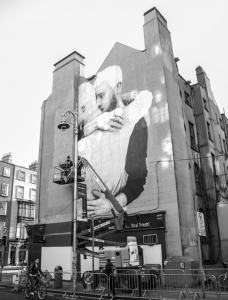Political Space and Art: Murals and Activism in Ireland -1
政治空間とアート: アイルランドの壁画とアクティビズム -1
Walking through a city, any city, we encounter a multitude of surfaces– the surface upon which we walk, others we have cause to touch, and our visual encounter is dominated by the outer façades of architectural structures. We experience the interiors of relatively few buildings, re-visiting the familiar spaces inhabited through our work and leisure. Indoor spaces range from the very public of government buildings and transportation hubs, to the private spaces of domestic life and intimacy. Outdoor areas of the urban landscape are predominantly occupied by the public, but to whom does the space belong?
What appear to be public areas are often extensions of private construction projects, left available for limited public access in return for a reduction in property tax or ease of planning permission. To test this theory one has only to erect a camera tripod in what appears to be a public space, say in an open plaza in front of a train station or popular meeting place, to be informed by a promptly-arriving guard that filming is strictly prohibited on the privately-owned property.
As public spaces continue to shrink in size and in number throughout cosmopolitan cities all over the world, the available public space for political engagement is becoming increasingly limited. Public demonstrations or activism on private properties rely on the complicity of the owner, without any obligation to be unbiased. Under laws or planning regulations, the outer walls of private buildings are also restricted with regards to political voice. The surfaces of walls have long been sites of visual expression– from human beings’ earliest evidenced visual expressions in the caves of Lascaux, to political expression on the west side of the Berlin Wall and the walls dividing wealthy neighbourhoods and Favelas in Brazil, and the murals of Northern Ireland’s segregated housing estates throughout the Troubles– nationalistic/sectarian conflict in Northern Ireland since the late 1960s. My third example is one I would like to discuss further as a precursor to some examples of the current state of political and artistic expression in Ireland today.
The arts have long been a means of veiled and overt political sedition, and still are today. In Irish literature, theatre and music, songs of protest, loss and defiance abound, and the political has taken many forms in the visual arts. During the height of the Troubles and still today, Catholic and Protestant communities are demarcated by the presence of large-scale political murals on the end walls of terraced housing estates. The painted surfaces remind Loyalists and Republicans where they can and cannot walk, but furthermore, martyrs are immortalised, events commemorated and communities, divided, show their respective presence and strength. As a country, the history of Ireland spans thousands of years, but the Irish Republic is less than 100 years old, shadowed by the irresolvable political problems that come hand in hand with dividing a country, north and south.
Political murals are far from unique to Northern Ireland, but the scale, skill and prevalence has been immense. Growing up in the Republic these murals were part of daily news broadcasts and a constant in the media, and no doubt have shaped the thinking of subsequent generations. The marriage equality referendum in 2015 in Ireland saw an impassioned engagement with politics from the younger generations of voters, dedicated to making their country a more open society than the one in which they were raised. With this youthful enthusiasm came creative and ambitious modes of expression centered around bringing the issue of marriage equality, and the taboos of homosexuality and non- binary relationships that it incorporates, into everyday conversation across generational and social divides. The innovative and heart-warming ringyourgranny campaign encouraged young people to call their grandparents and speak directly about the issues, and spread nationwide through YouTube, Twitter and various websites and social media platforms.
But perhaps the most memorable image of the lead-up to the referendum was an image by artist Joe Caslin that was featured across news and social media. The image is in fact one of two. Each picture features a same- sex pair in a moment of embrace. The image of the male couple was pasted onto the façade of a four-storey building on the corner of Dame Street and South Great George’s Street in the centre of the capital city. The image of the female pair was affixed to the sidewall of a castle in County Galway in the west of Ireland. There was no text included to state the political view of the author, but the content and timing of their appearance made them a clear proponent of the “Yes” vote campaign. The biodegradable prints were fixed to the wall using a potato-based adhesive, designed to naturally fall away from the wall surface after rainfall, and thus the “murals” were a temporary intervention. Documentation and sharing of the temporal artwork by the general public, however, has given it longevity. In this year, after Ireland’s referendum on marriage equality was concluded and the new law enacted, artists have continued to be politically active on a number of fronts.

Photo: Peter O’Dwyer
